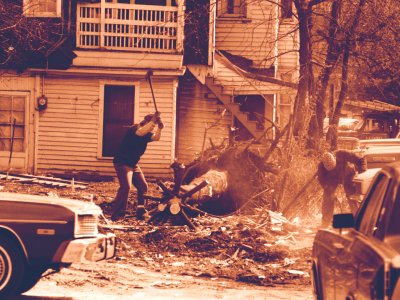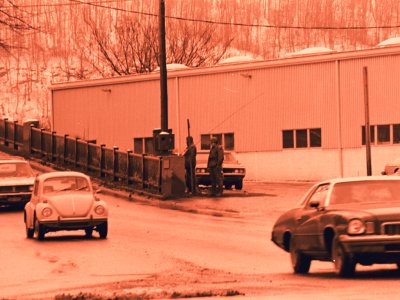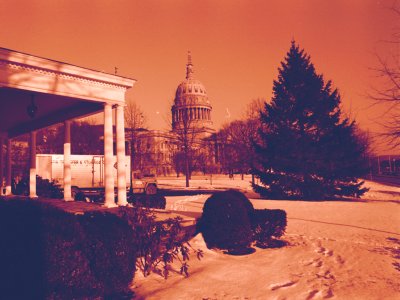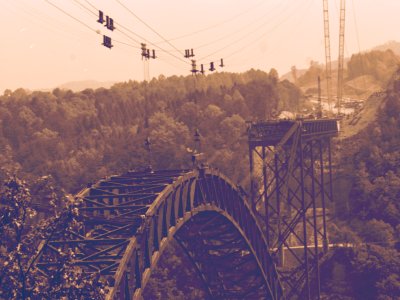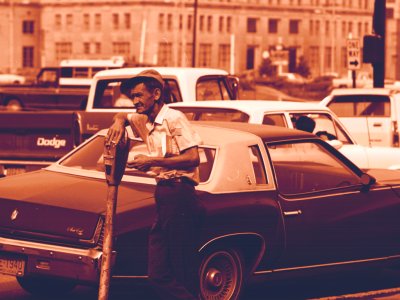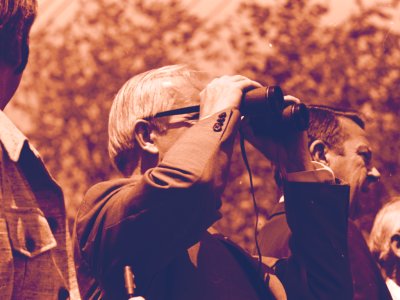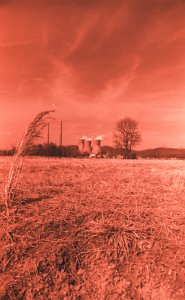17 Dec 2007
« Older Entries Newer Entries » Subscribe to Latest Posts
14 Dec 2007
Final Destination, Chapter 10: August 16, 3094
I had a deep and meaningful talk with Al this morning.
“Have you been able to extract any more messages from the data core?”
“No.”
“Do you think you are likely to?”
“No.”
And that was that.
My own research has been more promising. All of my time as of late has been spent working with the zero-point-energy plant located on the top floor of the research facility. I’m still amazed that this base had its own power supply, and I’m even more amazed that it could produce more power than the entire generating capacity of Tau Ceti. These people clearly kept their best technology for themselves.
It’s hard to imagine why they needed such a powerful energy source. My only guess is that it somehow ties in to their transporter experiments. The scientists in this research station wanted to create a wormhole that could be used to travel entire light-years in the blink of an eye, and that would take more power than I care to think about. If the starship that I used to get here could do that, the entire trip wouldn’t have taken more than a week.
The hard shell of the base must have protected the plant as it is surprisingly free of damage. I didn’t have any replacement parts with me but I was able to get it turned on by rerouting some of its wiring through undamaged backup units.
As soon as it was activated a list of log messages appeared on the plant’s control screen:
The #4 Zero-Point-Energy Plant has been powered down and is currently on standby mode. Standard lighting is available and wall panels are functional, but that is all. No other devices can be powered up until this plant is reactivated.
A system diagnostic has revealed that a few relays in the plant have failed. Full power should still be available but there may be difficulties igniting the reactor. These difficulties should not be fatal, however, as it should be possible to alter the reactor’s startup sequence to avoid them.
Posted by AI unit Charlie on January 1, 3094
The #4 Zero-Point-Energy Plant has been restarted and is now fully functional. All power should be available to all the systems on this laboratory. Diagnostic equipment indicates that some parts of the plant have failed, but these were not critical systems and should not interfere with the operation of the plant.
Posted by AI unit Charlie on August 12, 3094
I guess Charlie is still working after all these years. I’ve found the giant room that houses him (he’s enormous – the largest artilect I’ve ever seen) but I needed to get the power restored to the base before I could experiment with him.
It looks like the power plant was upgraded during their attempt to find a way to leave the planet. I found these messages in the plant’s maintenance log:
The power plant is being taken offline today, right on schedule. For now the base is continuing to function via a system of batteries, and they should last until we get the power plant put back together (although they may need some generator assistance, which shouldn’t be hard to get). I’m still a little unsure of the whole procedure, though: I understand the need for more power, but despite what Charlie says I really don’t believe you can get -that- much more power out of this machine no matter how much you overhaul it. Zero-point-energy is a fine thing, but you can only do so much and the level of power they’re requiring is orders of magnitude above anything we’ve been able to get before.
We’re having to beef up the superconducting cables between the plant and the wormhole transporter on the lower level: the old wires couldn’t even come close to carrying that many terawatts of power. (The rest of the base should be fine, since its electrical load will remain unchanged.) It takes an insane amount of energy to create a wormhole.
I have been encouraged at the results Dr. Braxton’s team has obtained so far. She’s truly done wonders: her theories, combined with Dr. Durant’s tinkering, has already resulted in the creation of a wormhole transporter that can move things over a hundred miles – something no one had ever been able to do before. Flora’s even been able to keep Charlie in good order, despite the fact that he is being used in ways far outside his design parameters. We’ve been blessed, no doubt about it.
Will we be able to get off this planet before the shockwave hits us six months from now? I don’t know; I just don’t know. It’s too hard to tell from this point: we’re entering new areas of research and we can’t predict what we will find. We’re certainly doing our very best to save the lives of all those still alive on this planet – which, at last count, was just over 4,500 people.
We’re praying, we’re working hard, and we will see. I’m not overly concerned about myself, for I’m ready to die. My concern is for those around me: there are so many people who are just not ready.
Posted by Gregory Sardis on September 20, 2814
The power plant has been put back together! It only took two weeks to overhaul it, just as Charlie predicted, and it is now generating precisely the amount of power he forecasted. I guess the geeks in the computer science division know what they’re doing after all! I’m impressed.
Now it’s up to Dr. Braxton and her team: can they get the wormhole transporter to work, or will this planet become our tomb? Astronomy has already located a nearby habitable planet: a star two light-years away has a planet that would suit our needs. Whether they can create a wormhole that will allow us to step through a doorway and appear right onto the surface of that planet, though, is anyone’s guess. We’re keeping the issue in our prayers.
Posted by Gregory Sardis on October 5, 2814
I’ve never even heard of a computer before that could design entirely new technologies. Charlie must be one amazing machine.
I’m going to turn my attention to him next.
11 Dec 2007
Final Destination, Chapter 9: August 12, 3094
Today I am back inside the Spatial Mechanics Laboratory. It is a large, gloomy building, filled with giant spherical rooms with glassy, reflective floors. Much of the machinery here is entirely new to me, and almost all of it is badly damaged. There are two key pieces of machinery that are particularly interesting: the artilect and the zero-point energy plant. The lower levels may have more interesting things but I haven’t found a way to access them yet.
Al, fortunately, is not here to make sarcastic comments. I am pleased.
It really looks like their research did not go well. I’ve found a laboratory that was sealed off from the rest of the base due to some very strange radiation poisoning. I’m not really sure what happened in there, but whatever it was damaged the equipment in that room in an unusual way; I’ve never seen matter with quantum imbalances before. It’s way beyond my expertise.
I was able to find a few messages stored on the door that sealed the laboratory off from the rest of the base:
Warning: this laboratory has been declared extremely hazardous, and all access to this area has been denied. Please do not attempt to raise the door or evade the security precautions. A serious accident has occurred in this laboratory and quarantine must be maintained at all times.
Any further spatial displacement experimentation must be conducted at one of the laboratories on the lower level of this base. Please see Dr. Braxton for more details.
Posted by Dr. Harold Webb on April 22, 2814
Accident Report
On April 21, 2814 a crew of scientists, led by Dr. Henry Durant, were engaged in a series of experiments designed to test procedures involved with the creation of stable, small-scale wormholes. Dr. Durant was pursuing the construction of a small wormhole transporter and, under the supervision of Dr. Braxton, was transporting small items a few feet at a time.
During the experiments the transporter began to exhibit unexpected behavior. At first a soft yellow light filled the room, coming from no known source. A few minutes later the materials in the nearby storage cases began to transmute into an unknown element, after which the experimental transporter burst into flames.
When the team realized that something unusual was going on they immediately evacuated the laboratory. Another team came in to investigate the strange occurrence, but their readings were meaningless and the decision was made to seal off that laboratory.
The accident is under investigation, and the design of the transporter is being rechecked to discover what might have happened. A further report has been filed and is available from Charlie.
Posted by Flora Sumner on April 22, 2814
I suppose that’s what happens when you are attempting things way out of your league.
Charlie, I’m guessing, must be the nickname for the AI unit that governed the research center. I wonder if he was any better than Al; for all I know they could be related.
I was able to find a few biographical pieces on the people involved on the incident:
Dr. Henry Durant
Born: December 28, 2759
Died: —-
Physical Appearance: Black hair, hazel eyes, 5′ 11″.
Discipline: Has a doctorate in spatial mechanics with a specialty in high energy theory.
Occupation: Is currently a division leader at the Larson’s Folly Spatial Mechanics laboratory, where he is experimenting with wormhole transporters.
Security clearance: Beta Prime
Last updated: January 1, 2815
Flora Sumner
Born: January 19, 2762
Died: January 4, 2815
Cause of death: Food poisoning
Physical Appearance: Red hair, brown eyes, 5′ 7″.
Discipline: Has a doctorate in artilect mechanics and a minor in chaos theory and matrix stability.
Occupation: The system administrator of Charlie.
Security clearance: Beta Prime
Last updated: January 4, 2815
Artilect: short for “Artificial Intellect,” it is commonly used to denote a machine with an advanced form of artificial intelligence. People frustrated with these units and unaccustomed to their usage often refer to them as “artificial idiots”.
Last updated: January 1, 2815
I guess all artificial intelligence units really are the same.
It’s odd that Flora died just a few weeks before the planet was destroyed. That would be like being diagnosed with a terminal illness and then being killed by a bus. I guess it’s better than being burned to cinders by a giant wave of plasma, but it’s still strange.
The psychological impact of the impending destruction of the entire planet must have been enormous. Everyone on the planet knew about it, and they also knew that, barring a miracle, none of them were going to survive. In a very real sense they knew the exact moment that they were going to die, and that can’t have been a comforting feeling. How could you possibly live knowing that your entire world would be gone forever in a few short months?
Everyone definitely didn’t handle it the same way. I’ve found a few different statements dating back to that time period that show a wide variety of emotions; some people coped with it well and others didn’t. For example, here’s a note that was written by the technician involved in the laboratory accident:
I am so excited! I feel more alive than I ever have before. It’s as if I had been asleep all my life and am just now starting to wake up.
We were all upset when we heard that our home was going to be destroyed in one year and that, very likely, we would all die. A lot of people went into shock. While everyone knows that they are going to die eventually it’s not something that I’d spent much time thinking about. Knowing that we had all been condemned to death was frightening.
It really made me stop and think. What was going to happen when I died? Was I going to go somewhere or was that just the end? A lot of people these days believe that the universe is an accident and death is just nonexistence.
But not me. As far back as I can remember I had believed that the universe was created by God and that one day I would have to answer for the way I had lived my life. That didn’t bother me until I realized that I would be measured against God’s standards, not mine. I always thought I was basically a good person: I hadn’t murdered anyone or robbed any banks, and I treated other people pretty decently. But God said that any violation of His commandments – even right down to selfishness and lies – was the equivalent of breaking the entire law. Even worse, God did not grade on a curve. He was holy and just, and those who had sinned deserved its penalty: eternal death in a place called the lake of fire.
I was in trouble and there was not a thing I could do about it. There was nothing I could do to repay God for the times I had broken His commands. He didn’t care about the good deeds I had done, and no amount of goodness on my part could blot out my record. The only way my debt to God could be repaid was if someone who had a perfectly clean record took the punishment that I deserved, but there was no such person, and even if there was, why would they want to die in my place?
God, in His great mercy, found a way. He loved the world so much that He sent His son Jesus to become a man, live a perfect life, and die in my place, taking the punishment that I deserved. He died a cruel death and then rose from the dead, proving His power over it. I could be saved from eternal death if I would simply believe in Jesus. I had a choice: I could continue being my own master and die, or I could accept Jesus as my master and be saved. There was no other way.
Brandon always argued with this and said that he would bow to no one. I told him that what mattered was whether or not the claims of Jesus were true. If they were true then everyone should believe them; if they were lies then everyone should ignore them. Disbelief in things that are true carries a great cost.
A year from now the planet Larson’s Folly (our dear home) will become an asteroid field. If I am still on the planet when that happens I will be instantly killed. What happens next? I had believed in Christ for some time but I hadn’t seriously thought about life after death until these past few days. Jesus talked a lot about the afterlife while He was on Earth. What did He have to say about it?
When I die eight months from now (assuming we don’t find a way off our world) I will immediately go to a place that Jesus called Paradise, a word that refers to a walled garden. We usually call it Heaven, and it’s every bit as real a place as any planet or star in the galaxy. There I will live with Jesus until God calls an end to the Universe, at which point everyone will be judged for the things they did in life. Those who would not let God rule over them will be cast into outer darkness, which is a horrible place of eternal pain – but something else is in store for those who were saved.
Jesus did not promise to make all new things; He promised to make all things new. He restored my relationship with God by His death. My physical body will die, but He will bring this physical body back to life and make it incorruptible. When Christ rose from the dead His tomb was empty because the body that was slain was raised again. My tomb will be just as empty.
The universe will come to an end, but Jesus has promised that after the final judgment, He will renew it. When I die, I will leave this body and this place, but one day God will rebuild them both and I will return to live in them forever with my Lord.
What lies ahead of me is not a vague spiritual existence but an everlasting life with real trees, real streams, real streets, real buildings, and no crime or pain. I will be at the place I have longed for all my life with the Person I love more than any other. My life is not going to end a year from now; it will just be starting.
God didn’t invent death; it came as a consequence of man’s sin in the Garden of Eden. What Jesus did was conquer it and offer us a way to live forever with Him. I don’t have to be afraid. Each moment I am here is an opportunity to serve the Lord wherever I’m at, and nothing can take away my life until God is ready to bring me home. I have nothing to fear for He has taken hold of me and will not let me go.
I am excited.
Posted by Flora Sumner on July 2, 2814
The prospect of imminent and possibly unavoidable death did not disturb Flora, but not everyone on the base shared her feelings. Take the base chef, for instance:
I think this is all a waste of time, personally. I mean, come on! People have been trying to build a wormhole transporter for a thousand years; what makes Anna think she can succeed where everyone else failed? It’s a pipe dream meant to comfort people with weak minds. They’re never going to get a wormhole transporter built with enough range to transport everyone to another planet. Everyone here is going to die, and March 28, 2815 is going to be our doomsday.
The bigwigs have as much as admitted it. I heard last week that they’ve started building underground bunkers deep underground, and on March 19, 2815 they’re going to evacuate everyone to the bunkers and empty the base. As if bunkers will protect us when the planet itself is disintegrated! It’s all idiocy, no matter what Charlie says.
I say eat, drink, and be merry, for next year we die. Why bother spending long hours trying to do the impossible when you can spend your last days enjoying yourself instead? There is nothing beyond death but non-existence. All of us are products of random chance, accidents in a meaningless universe where there is no such thing as good or bad or God. Life is meaningless, and searching for meaning where there is none is a hopeless waste of time.
Of course, you’ll never get Flora to admit that. I’ll never understand how anyone smart enough to earn a doctorate in chaos theory (of all things!) could be stupid enough to believe in God. She won’t listen when I tell her the universe evolved; no, she says that God created it in six days, and she blathers on and on about how you can’t create information by random processes, and that no mutation has ever increased the genetic information in a creature. I don’t even try to argue with her anymore.
I’m convinced that Flora and her religious friends would have been kicked off the base years ago if it wasn’t for the fact that we can’t live without them. Flora is the only surviving expert in artilect mechanics that we have, and she alone can repair Charlie whenever he breaks down (which is increasingly often these days). I guess we’ll have to keep them, but they are so judgmental and intolerant. Who has the authority to tell me what’s right and wrong?
All I say is, just give me another drink and I’ll be happy. Who cares what happens tomorrow?
Posted by Arnold Brandon on March 25, 2814
I’ve been able to find a few things out about this Arnold Brandon. He worked in the base cafeteria, where I was able to extract this information:
The cafeteria for this base (lovingly known as Ulcer Alley by those who frequented it) has been shut down indefinitely, and everything in the baking area has been removed.
This area was shut down on March 19, 2815 by order of Arnold Brandon. At that time the chief cook Duncan Skene was relieved of his charge over this area and was evacuated with the rest of the base personnel (who appeared to be eager to leave). The cafeteria is officially unmanned, so if you’ve come for a bite to eat you might be waiting a while. A long while.
Posted by AI unit Charlie on March 19, 2815
Arnold Brandon
Born: September 27, 2774
Died: —-
Physical Appearance: No hair, gray eyes, 6′ 2″.
Discipline: Has a degree in culinary arts with a specialty in vitamin theory. (Yes, vitamin theory, one of the many majors available at Glen Allen University.)
Occupation: Used to be the chief cook at the cafeteria at Larson’s Folly Spatial Mechanics laboratory, but when the base was shut down he was relieved of his post. His current job is unknown.
Security clearance: None.
Last updated: March 19, 2815
I’ll continue to investigate to see what else I can find. There is a lot of equipment here that I can’t use at the moment because it is not powered. If I can get the zero-point-energy plant here at the facility to work then perhaps I’ll be able to piece together a few more clues.
7 Dec 2007
Final Destination, Chapter 8: August 7, 3094
I quickly discovered that Al was right. Trying to extract more information from their encrypted data core was like trying to piece back together a grenade after it has gone off: you know the pieces all had to be there at one point, but there’s just not much left and it’s anyone’s guess as to whether you’re reassembling it correctly.
Al and I had been trying to sort through the surviving data for the past 24 hours, beginning with the oldest data and continuing from that point. The key question was obvious: did they see the blast coming and, if so, what did they do to avoid it?
“So what do we have, Al?” I asked.
“It looks like your hypothesis was correct, Miles Porter. The inhabitants of the planet were aware of their impending destruction. I have been able to extract the following series of notes from the data core.”
Al loaded the following messages onto the cockpit console:
The Larson’s Folly Spatial Mechanics laboratory was placed in suspended mode on March 19, 2815 by the order of base commander Harold Webb. The power plant has been placed in standby mode and is only generating enough power to sustain basic lighting and panel interfaces. All personnel have been evacuated and are seeking shelter from the impending stellar shockwave.
All hardware components containing critical computer data have been removed to a secure, off-site location. Data and messages deemed unimportant or non-critical are all that remains in the system, so further information may not be available.
This laboratory has no contact with any other systems on the planet. Any restoration of base functions will have to be done manually. The link to the FTL Research Station has been lost.
Posted by AI unit Charlie on March 19, 2815
“You’re right,” I said. “It looks like they did know what was about to happen, but they were unfortunately still on the planet just a few days before the plasma hit. What else did you find?”
The computer brought up another note on the console:
Effective immediately, the function of this laboratory is changing. All lines of inquiry not related to spatial displacement will be abandoned, and every personnel will do everything in their power to assist Dr. Anna Braxton in her research. This is absolutely critical for the survival of everyone on Larson’s Folly.
As you may or may not know, depending on what sort of access you have to the local media, this planet is doomed. Astronomers working at the Belzoni Planetary Telescope noticed a month ago that a star one light-year away from us showed signs of becoming unstable. According to their calculations, which I am told cannot be in error, the star actually blew up last week, and the shockwave and debris from it will hit this planet in one year.
If you look up in the night sky you will not see anything out of the ordinary. It takes a year for light from that star to reach us; while the star has already exploded, we won’t see the actual explosion until a year after it actually happened. The light we are now receiving from that star is already a year old. However, the stages of instability in stars are well known and there is no question what is going on. There is also no question that when the shockwave hits us it will break our planet into small, charred pieces. All living things on this planet, regardless of how well shielded they are, will die.
Dr. Camdon was able to pinpoint the exact arrival of this shockwave with great accuracy. He predicts the arrival to occur at between 7am and 8am on March 28, 2815 A.D. We have between now and then to find a way to get off this planet. If we fail then all of us will die in a little over a year. We have put out a general distress call for help, but as far as we know all other colonized star systems are much too far away to send any help before the shockwave hits, and besides, none of them have starships any more than we do.
We believe that we have a fighting chance of getting off this planet. Dr. Braxton’s research into spatial displacement has shown great promise, and may overcome the fact that we have no way of building a starship.
It is too soon to tell if her research will pan out, but we are cautiously optimistic at this point. We are not all dead yet, so let’s work together and overcome this challenge!
Posted by Dr. Harold Webb on March 16, 2814
“This isn’t exactly what I would call good news,” I said. “A year before it all started they were aware of the problem, and a few days before the blast hit they were still trying to relocate things to “secure off-site locations”. Unless that was referring to another star system, they were in mighty big trouble. Is there any indication that they were able to make it off the planet?”
The computer brought up another note:
It has come to my attention that some people on this base are suggesting that we should abandon the attempt to build a working long-range transporter and, instead, focus our efforts on building a faster-than-light spaceship. Since the discussion on this topic has reached a point where it has become a distraction to the work being done, I have decided to address it and put an end to the debate.
The proponents of the wormhole drive say that building a wormhole that can span two light-years is incredibly difficult, and we just do not have enough time before the shockwave hits to master this technology. They say that it would be much easier to create a spaceship with a wormhole drive: the drive would create a small wormhole which the ship would travel through, and it would then create another one, and another one, until the ship reached its destination. Since smaller wormholes are created, the difficulties associated with creating extremely large wormholes vanish.
This idea was considered by those in charge of this base and has been rejected. It is true that small wormholes are easier to create than large ones, but at this time we have no way of creating a spaceship of any kind, and even if we could, we have no way of launching it into space. We believe that it would take a minimum of ten years to create such a ship, and we do not have ten years.
This topic should now be considered closed. We have a lot of work to do, and we should stick to it: if we become distracted and fail, we will all die.
Posted by Dr. Harold Webb on July 3, 2814
“So you have made some progress,” I said, “although the messages aren’t encouraging. I can’t believe that they were trying to develop a wormhole transporter; even to this day no one has been able to do that. Why on earth did they abandon the idea of a starship? That would have been so much more practical. It’s not looking good, Al.”
“I have found a few more entries,” the computer replied. “You may find them to be of interest.”
“Ok, let’s have them.”
Dr. Harold Webb
Born: October 9, 2761
Died: —-
Physical Appearance: Brown hair, brown eyes, 5′ 8″, slight build, weak stomach. Has a sharp temperament, and is not an easygoing individual.
Discipline: Has an advanced degree in higher mathematics with a specialty in relativity theory.
Occupation: Is currently the base administrator at the Larson’s Folly Spatial Mechanics laboratory. He also assists spatial mechanics research.
Security clearance: Alpha Prime
Last updated: January 1, 2815
Larson’s Folly: This remote planet, located near the heart of the galaxy, was named after a planet in a series of books published in the early 21st century. The title comes from a book entitled “The Lost Tomorrow,” which dealt with a wayward tachyon beam that traveled back in time and radically changed the future for the worse. In the adventure a Starman Joe Taylor lands on an incredibly inhospitable planet named Larson’s Folly, which no one really knew very much about.
This planet was named by the Planetary Engineering Core (PEC) on July 16, 2574 A.D. by someone who was evidently a fan of this very ancient series.
“Hmmm. So that’s where the name came from! I always wondered, as it was never recorded anywhere. I guess that’ll come in handy if I’m ever on a game show.”
It was late, so I decided to call it a day and get some sleep. Tomorrow I would try to find some more information. The base was filled with small computer panels; perhaps one of them would have some more clues.
4 Dec 2007
Final Destination, Chapter 7: August 6, 3094
“Ok, Al, let’s go over this. We’ve been here for almost two weeks now.”
“Nine days, to be precise,” the computer replied.
“Right – nine days. So what have we learned?”
“It would appear that this base is the only surviving artifact of the people who once inhabited Larson’s Folly,” Al said. “The probes I have released have found no other artifacts, debris, beacons, messages, or spacecraft.”
“How far out have you checked?” I asked.
“I have examined everything within a two light-year radius, Miles Porter. I could not have missed anything smaller than a shoebox.”
“I’m glad we’re not looking for shoes, then,” I said. “But keep going. What else have we learned?”
“You were able to get the door open, after some effort, and began an examination of the base itself. I could not join you inside the base so that is where my knowledge ends.”
“Some effort is right; it took three entire days. The mechanism was fried so I had to short-circuit the door and connect it directly to your power supply to get it to open. It was not an easy task.
“Anyway, Al, you’re right: this base is all we have to go on. That is the bad news. I had hoped to find a pot of gold at the end of the rainbow but it turns out there aren’t even any leprechauns – just a pot. The good news is that we do have the pot and it might yield a few clues.
“The best news of all is that the data core of the research station seems to be relatively undamaged. We should be able to read its data and possibly find out what happened. If we are correct and this is a research station then there may even be some research files on that data core, which would be a huge find. It may be tricky to restore the data but I know you can do that: there’s an entire chapter on it in that manual of yours.”
“Very good, Miles Porter. Bring me the data core and I will do what I can.”
I was beginning to feel somewhat optimistic.
Three hours later I wasn’t feeling quite as optimistic. “What do you mean, you’re having trouble reading the data?”
“The server that you obtained for me, Miles Porter, was heavily secured. If you will recall, the people on this planet kept very careful track of their research. They guarded it with the utmost secrecy and took great pains to encrypt their secrets. The data is on this server is both encrypted and damaged at that. You are asking me to decrypt damaged data to which I have no key. That is an almost impossible task.”
“Wonderful,” I said. “Just wonderful. Isn’t there anything you can find out? Anything at all?”
The computer paused. “There are some sections that stored unencrypted data and a few facts can be gleaned from that. For instance, it would appear that this facility was called the Spatial Mechanics Laboratory.”
“Ok, that’s a start. Are there any unencrypted notes?”
“There are a few. Here is the most recent one that I have been able to recover so far.”
The computer loaded a document onto a nearby console. It read as follows:
The planet Larson’s Folly was hit with a stellar shockwave at 7:14am on March 28, 2815 A.D. According to instruments, the planet immediately broke up and suffered tremendous devastation: the atmosphere was blown off the planet, the ocean boiled away, and all life on the plant was destroyed. There is no indication that anything has been left alive on this planet.
This base happened to be on the opposite side of the planet from where the shockwave hit and it survived relatively intact, although part of the lower floor has been destroyed. Based on local gravity readings, this base is now floating on a fairly large asteroid and is no longer a part of the planet; indeed, the planet itself has been broken up into a host of small asteroids. The planet of Larson’s Folly is no more.
Posted by AI unit Charlie on March 28, 2815
“Amazing,” I said. “That’s exactly what we are looking for, Al. Keep searching through that data core and let me know if you find anything else.”
The pieces were beginning to fall together. “Tell me, Al, are any nearby stars missing?”
“Yes, Miles Porter, there are a number of stars that are missing in this area of space. To anticipate your next question, this phenomenon can be traced back to a single source. It would appear that the star ZMX-10343-D, located approximately one light-year away, was detonated at some point in the past. This produced an expanding spherical debris field that was centered on the old position of that star.”
“What do you mean by detonated? Do you mean it went supernova?”
“No, Miles Porter. Had it done so there would have still been some remnant of the star left. In this case something instantly converted the star’s entire mass into energy, and that energy expanded out in all directions and created a wave of plasma that moved at the speed of light. The plasma wave obliterated anything it touched within a radius of 10 light-years.”
“Ah. Yes, I can see that. Do you know what caused it?”
“No, I do not.”
“So a star one light-year away blew up,” I said, “and it generated a plasma field that traveled at the speed of light in this direction. That means it would have taken a year to get here. Right?”
“Right.”
“Do you suppose that the people on Larson’s Folly knew in advance that their doom was approaching and, perhaps, managed to escape?”
“I can’t answer that question,” the computer replied.
“Then let’s find the answer.”
3 Dec 2007
Earle Neil Kinder: Squirrel
30 Nov 2007
Final Destination, Chapter 6: September 27, 3094
“I have some results,” the computer told me this afternoon.
“Wonderful,” I said. “It’s about time. What have you found?”
“It looks like my plasma hypothesis is correct, Miles Porter. Based on the analysis of the rock samples that the probes have obtained it would appear that sometime around the year 2800 this system was struck by a fast-moving wave of plasma that obliterated everything in its path. The rocks that survived were probably on the side of the planet opposite to the plasma, so they had some protection. The rocks indicate that the plasma composition – ”
“Who cares about the plasma composition, Al! Get to the point, please. Did you find any signs of life? Any artifacts?”
“I am not done with my report, Miles Porter. There is important plasma data – ”
“Yes, Al, you are done with your report. You are not going to tell me about the plasma’s chemical composition. Tell me about the artifacts.”
“I have found one artifact so far, Miles Porter. It would appear that a section of a facility survived the blast and is still intact.”
Al loaded some probe data onto the cockpit console and started showing me some pictures. “This particular fragment, which I have labeled 0141-5926-5358, is an oblong rock fragment 3 miles by 4 miles by 9 miles at its longest points. It has on it a section of research facility that at one time must have been deep underground. The facility does have some damage but its outer walls were built out of an immensely strong shell and have survived relatively intact.”
The pictures the console displayed were encouraging. I could see what he meant: the outside of the facility was burnt down to bare metal but the building itself looked intact. Part of it was protruding out of the ground, but the computer believed that there was another section located underground.
I was pleased. “This is terrific news, Al! Well done. Take us there and land outside the facility. Once we get there I’m going to go out and do some investigating.”
“Very good, Miles Porter. We should be there in about twenty minutes.”
The computer was exactly right. Twenty minutes later we had landed on the rock fragment (I guess you could call it an asteroid, although it wasn’t exactly orbiting a star). Al set the ship down squarely in front of the research base, which was much larger than I thought it would be. The front door was actually pretty large, and it presented me with my first problem.
“Ok, Al, so do you have any suggestions for opening the door?” I asked.
“I am not programmed to perform that function, Miles Porter. You will have to use your own resources.”
I looked at that huge door and grimaced. This would take a little bit of work.
28 Nov 2007
Earle Neil Kinder: Meter Man
27 Nov 2007
Final Destination, Chapter 5: September 23, 3094
“How’s it going?” I asked. We’ve been here for three days now.
“Tolerably well, Miles Porter. I have launched a cloud of small probes, and they have begun exploring the rocks that I have located. They will report their findings once we reach them. I should have some results in four days.”
“Hey, that’s pretty cool,” I replied. “I didn’t know you could do that.”
“I have many capabilities that you are not aware of, Miles Porter. You really should read the user’s manual. Had you started when the trip began you could have finished its 5,203 pages by now. I did ask you to, if you will recall.”
“Yeah, I know. I had more pressing things to attend to, like watching the mold grow downstairs. You never did tell me how to get rid of it, by the way.”
“Mold removal, Miles Porter, is not a part of my programming. You will have to attend to that yourself. I would suggest using bleach.”
“Do we even have any bleach aboard, Al?”
“No, Miles Porter, we do not.”
I sighed. “Let me know when your probes find something. I’m going to be downstairs reading your user manual. Maybe I’ll find a way to turn you off and finally get some peace.”
“Very good, Miles Porter.”
It had been a huge blow to find the entire planet missing. At least a few fragments survived; perhaps one of them held a clue. I really did not want to come back home empty-handed: Tau Ceti was dying and I knew that I was their last chance. If I couldn’t find a way to repair our technology then no answer would be found, and in a hundred years most of us would be dead and the lucky survivors would be depending on stone knives and bearskins. I had to find something.
23 Nov 2007
Final Destination, Chapter 4: September 21, 3094
It was the most horrible day of my life.
This morning I woke up, as excited as could be. “This is it!” I told Al enthusiastically. “It’s taken us eighteen months, but we’re finally here. How far are we from home?”
“1,479 light-years,” Al said.
“Great,” I said. “Just go ahead and enter orbit around Larson’s Folly and we’ll take it from there. Let’s do an aerial survey before we actually land.”
The computer paused. “I’m afraid I can’t do that, Miles Porter.”
“Oh? And why would that be?”
“Because, Miles Porter, there is no Larson’s Folly.”
That got my attention. “What do you mean, there is no Larson’s Folly? Did you get us lost or something? Don’t tell me that you took a wrong turn or that we went in the wrong direction.”
“I am offended by your lack of faith in me, Miles Porter. I do not make mistakes. These are the coordinates for the star system that was said to contain Larson’s Folly, but it is not here.”
“You mean the entire planet is missing?”
“I mean, Miles Porter, that the entire star system is missing. None of the planets are here. The star is not here. There is, in fact, no longer a star system at this location.”
“You’re kidding,” I said. “Do you mean to tell me that Larson’s Folly was just a hoax?”
“Hardly that,” the computer replied. “It existed at these coordinates; of that I am sure. However, it no longer exists at these coordinates. The entire star system has been destroyed.”
“Destroyed! What on earth do you mean, destroyed? You can’t destroy an entire star system! The worst the war could have done was lay waste to the surface of the planet, Al – you ought to know that. Nobody ever developed a weapon that could vaporize an entire star system. That’s just not possible.”
“I am afraid it is, Miles Porter. There is no longer a star at this location, but there used to be. There are no longer planets in this area, but there are a few charred pieces of rock left. Something has laid waste to the entire star system. There are no longer any planets here.”
For several hours I could do nothing but sit there and stare out the cockpit window. He was right: the star really was missing. And the planets. And the moons. The whole thing was just gone, and I didn’t know what to do.
I didn’t know what I was expecting to find when I got here, but I was definitely not expecting to find nothing. I thought there would at least be ruins left that might hold something that I could bring back to Tau Ceti. To come all this way and find nothing was unbelievable.
“What happened?” I said aloud.
“I do not know,” the computer replied. “Would you like me to try to find out?”
“Yes,” I said. “Do some scanning. See if you can find ruins, rocks, I don’t know, anything. There’s just got to be something out there, Al. We can’t have come all this way for nothing.”
“I will let you know what I find.”
I knew the war had caused a lot of damage. It destroyed all the tachyon matter transporters and the tachyon communicators, which cut off the colonies from each other. It laid cities to waste and blew things up and destroyed the Commonwealth. But this was impossible.
There had to be something left. There just had to be.
“I have found some things that may be of interest,” the computer said a few hours later.
“Let’s have it.”
“Aside from random particles, intense radiation, and clouds of gas, there are what appears to be the remnants of a few planets. I have been tracking the course of a number of fragments of charred, melted rock, some of which are as large as a few cubic miles. It would appear that a source of intense plasma struck the planets at an enormous speed and broke them apart, and in the process destroyed the star as well.”
“Ok,” I said. “Let’s do this. It took us forever to get out here and I’m not about to leave until I’ve exhausted every possible option. Let’s search each and every one of those rock fragments that are out there to see if we can find any clues. It might be – I don’t know. Maybe we’ll find something. We’ve got to try, Al; we’ve got to exhaust every possibility before we leave.”
“Very good, Miles Porter. I will begin my investigation. This may take some time.”
“Take all the time you need,” I replied. “Just don’t miss anything. There’s got to be something left.”
-
Browse
or Tag Cloud
artwork at the end of eternity beyond the farthest star earle neil kinder in the city of tomorrow jack falcon kings oddities photo randomly generated books science fiction second coming short story starman series stryker series theology the war of the artilect Tom Swift and His Claytronic Stones Tom Swift and His Nuclear Hyperplane tom swift jr

